Evolution of Nanostructure and Metastable Phases at the Surface of a HCPEB-Treated WC-6% Co Hard Alloy with Increasing Irradiation Pulse Numbers
Abstract
:1. Introduction
2. Materials and Methods
3. Results
3.1. XRD Analysis of the Phases
3.2. Fine Scale Microstructure Evolution Aspects with EBSD and TEM
4. Discussion
5. Conclusions
- Nano domains composed of WC1−x (fcc), Co3W9C4 (hcp), and Co3W3C (hcp) were formed at the interface and Co-rich area after HCPEB irradiations. The formation and area fraction evolution of which mainly contributed to the surface mechanical properties improvement;
- Nano graphite as well as ultrafine-grained WC1−x (fcc) were formed in the WC-rich area after HCPEB, the formation of which decreased the surface friction coefficient;
- With the increasing number of pulses, the area fraction of the nano domains increased and reached its highest value (~40%) after 20 pulses of irradiation. After that, the area fraction of nano domains decreased slightly as a result of surface crack propagating.
Acknowledgments
Author Contributions
Conflicts of Interest
References
- Poate, J.M.; Foti, G.; Jacobson, D.S. Surface Modification and Alloying by Laser, Ion, and Electron Beams; Plenum Press: New York, NY, USA, 1983. [Google Scholar]
- Rej, D.J.; Davis, H.A.; Nastasi, M.; Olson, J.C.; Peterson, E.J.; Reiswig, R.D.; Walter, K.C.; Stinnett, R.W.; Remnev, G.E.; Struts, V.K. Surface modification of AISI-4620 steel with intense pulsed ion beams. Nucl. Instrum. Methods Phys. Res. Sect. B 1997, 127–128, 987–991. [Google Scholar] [CrossRef]
- Proskurovsky, D.I.; Rotshtein, V.P.; Ozur, G.E.; Markov, A.B.; Nazarov, D.S.; Shulov, V.A.; Ivanov, Y.F.; Buchheit, R.G. Pulsed electron-beam technology for surface modification of metallic materials. J. Vac. Sci. Technol. A 1998, 16, 2480–2488. [Google Scholar] [CrossRef]
- Wood, B.P.; Perry, A.J.; Bitteker, L.J.; Waganaar, W.J. Cratering behavior in single- and poly-crystalline copper irradiated by an intense pulsed ion beam. Surf. Coat. Technol. 1998, 108–109, 171–176. [Google Scholar] [CrossRef]
- Chen, X.; Yan, L.; Karnati, S.; Zhang, Y.; Liou, F. Fabrication and characterization of AlxCoFeNiCu1−x high entropy alloys by laser metal deposition. Coatings 2017, 7, 47. [Google Scholar] [CrossRef]
- Zhang, X.D.; Zou, J.X.; Weber, S.; Hao, S.Z.; Dong, C.; Grosdidier, T. Microstructure and property modifications in a near α Ti alloy induced by pulsed electron beam surface treatment. Surf. Coat. Technol. 2011, 206, 295–304. [Google Scholar] [CrossRef]
- Zhang, K.M.; Ma, J.X.; Zou, J.X.; Liu, Y.R. Surface microstructure and property modifications in a duplex stainless steel induced by high current pulsed electron beam treatments. J. Alloy. Compd. 2017, 707, 178–183. [Google Scholar] [CrossRef]
- Wang, H.; Hao, S.Z. Surface nanostructure and improved microhardness of 40CrNiMo7 steel induced by high current pulsed electron beam treatment. Nucl. Instrum Methods Phys Res. Sect. B 2017, 403, 45–50. [Google Scholar] [CrossRef]
- Hao, S.Z.; Wang, H.H.; Zhao, L.M. Surface modification of 40CrNiMo7 steel with high current pulsed electron beam treatment. Nucl. Instrum. Methods Phys. Res. Sect. B 2016, 368, 81–85. [Google Scholar] [CrossRef]
- Hao, S.Z.; Li, M.C. Producing nano-grained and Al-enriched surface microstructure on AZ91 magnesium alloy by high current pulsed electron beam treatment. Nucl. Instrum. Methods Phys. Res. Sect. B 2016, 375, 1–4. [Google Scholar] [CrossRef]
- Mateos, J.; Cuetos, J.M.; Fernandez, E.; Vijande, R. Tribological behaviour of plasma-sprayed WC coatings with and without laser remelting. Wear 2000, 239, 274–281. [Google Scholar] [CrossRef]
- Ivanov, Y.F.; Rotshtein, V.P.; Proskurovsky, D.I.; Orlov, P.V.; Polestchenko, K.N.; Ozur, G.E.; Goncharenko, I.M. Pulsed electron-beam treatment of WC–TiC–Co hard-alloy cutting tools: Wear resistance and microstructural evolution. Surf. Coat. Technol. 2000, 125, 251–256. [Google Scholar] [CrossRef]
- Ramkumar, J.; Aravindan, S.; Malhotra, S.K.; Krishnamurthy, R. Enhancing the metallurgical properties of WC insert (K-20) cutting tool through microwave treatment. Mater. Lett. 2002, 53, 200–204. [Google Scholar] [CrossRef]
- Gnyusov, S.; Tarasov, S.; Ivanov, Y.; Rothstein, V. The effect of pulsed electron beam melting on microstructure, friction and wear of WC–Hadfield steel hard metal. Wear 2004, 257, 97–103. [Google Scholar] [CrossRef]
- Ulgov, V.V.; Anishchik, V.M.; Astashinski, V.M.; Cherenda, N.N.; Gimro, L.G.; Kovyaza, A.V. Modification of WC hard alloy by compressive plasma flow. Surf. Coat. Technol. 2005, 200, 245–249. [Google Scholar] [CrossRef]
- Ulgov, V.V.; Kuleschov, A.K.; Soldatenko, E.A.; Koval, N.N.; Ivanov, Y.F.; Teresov, A.D. Structure, phase composition and mechanical properties of hard alloy treated by intense pulsed electron beams. Surf. Coat. Technol. 2012, 206, 2972–2976. [Google Scholar] [CrossRef]
- Xu, Y.; Zhang, Y.; Hao, S.Z.; Perroud, O.; Li, M.C.; Wang, H.H.; Grosdidier, T.; Dong, C. Surface microstructure and mechanical property of WC-6% Co hard alloy irradiated by high current pulsed electron beam. Appl. Surf. Sci. 2013, 279, 137–141. [Google Scholar] [CrossRef]
- Hao, S.Z.; Zhang, Y.; Xu, Y.; Gey, N.; Grosdidier, T.; Dong, C. Fabrication of nano graphite precipitates and WC/Co composite surface structure by using high current pulsed electron beam. Appl. Surf. Sci. 2013, 285, 552–556. [Google Scholar] [CrossRef]
- Hao, S.Z.; Wu, P.; Zou, J.X.; Grosdidier, T.; Dong, C. Microstructure evolution occurring in the modified surface of 316L stainless steel under high current pulsed electron beam treatment. Appl. Surf. Sci. 2007, 253, 5349–5354. [Google Scholar] [CrossRef]
- Zou, J.X.; Grosdidier, T.; Zhang, K.M.; Dong, C. Cross-sectional analysis of the graded microstructure in an AISI D2-steel treated with low energy high-current pulsed electron beam. Appl. Surf. Sci. 2009, 255, 4758–4764. [Google Scholar] [CrossRef]
- Hao, S.Z.; Yao, S.; Guan, J.; Wu, A.; Zhong, P.; Dong, C. Surface treatment of aluminum by high current pulsed electron beam. Curr. Appl. Phys. 2001, 1, 203–208. [Google Scholar] [CrossRef]
- Hao, S.Z.; Zhao, L.; He, D. Surface microstructure and high temperature corrosion resistance of arc-sprayed FeCrAl coating irradiated by high current pulsed electron beam. Nucl. Instrum. Methods Phys. Res. Sect. B 2013, 312, 97–103. [Google Scholar] [CrossRef]
- Trent, E.M.; Wright, P.K. Chapter 7-Cutting tool materials II: Cemented carbides. In Metal Cutting, 4th ed.; Elsevier: Amsterdam, The Netherlands, 2000; pp. 175–226. [Google Scholar]
- Zou, J.X.; Grosdidier, T.; Zhang, K.; Dong, C. Mechanisms of nanostructure and metastable phase formations in the surface melted layers of a HCPEB-treated D2 steel. Acta Mater. 2006, 54, 5409–5419. [Google Scholar] [CrossRef]
- Guillermet, A.F. Thermodynamic properties of the Co-W-C system. Metall. Trans. A 1989, 20, 935–956. [Google Scholar] [CrossRef]
- Cho, T.Y.; Yoon, J.H.; Kim, K.S.; Song, K.O.; Joo, Y.K.; Fang, W.; Zhang, S.H.; Youn, S.J.; Chun, H.G.; Hwang, S.Y. A study on HVOF coatings of micron and nano WC–Co powders. Surf. Coat. Technol. 2008, 202, 5556–5559. [Google Scholar] [CrossRef]
- Jafari, M.; Han, J.C.; Seol, J.B.; Park, C.G. Tribological properties of HVOF-sprayed WC-Co coatings deposited from Ni-plated powders at elevated temperature. Surf. Coat. Technol. 2017, 327, 48–58. [Google Scholar] [CrossRef]
- Wen, Q.F.; Liu, Y.; Wang, Y.M.; Zhang, F.G.; Zhu, X.P.; Lei, M.K. The effect of irradiation parameters of high-intensity pulsed ion beam on tribology performance of YWN8 cemented carbides. Surf. Coat. Technol. 2012, 209, 143–150. [Google Scholar] [CrossRef]
- Qin, Y.; Zou, J.X.; Dong, C.; Wang, X.G.; Wu, A.M.; Liu, Y.; Hao, S.Z.; Guan, Q. Temperature–stress fields and related phenomena induced by a high current pulsed electron beam. Nucl. Instrum. Methods Phys. Res. Sect. B 2004, 225, 544–554. [Google Scholar] [CrossRef]
- Qin, Y.; Dong, C.; Song, Z.; Hao, S.Z.; Me, X.; Li, J.; Wang, X.; Zou, J.X.; Grosdidier, T. Deep modification of materials by thermal stress wave generated by irradiation of high-current pulsed electron beams. J. Vac. Sci. Technol. A 2009, 27, 430–435. [Google Scholar] [CrossRef]
- Bäuerle, D. Laser Processing and Chemistry, 2nd ed.; Springer: Berlin/Heidelberg, Germany, 1996. [Google Scholar]
- Demetriou, M.D.; Ghoniem, N.M.; Lavine, A.S. Modeling of graphitization kinetics during peritectic melting of tungsten carbide. Acta Mater. 2002, 50, 4995–5004. [Google Scholar] [CrossRef]
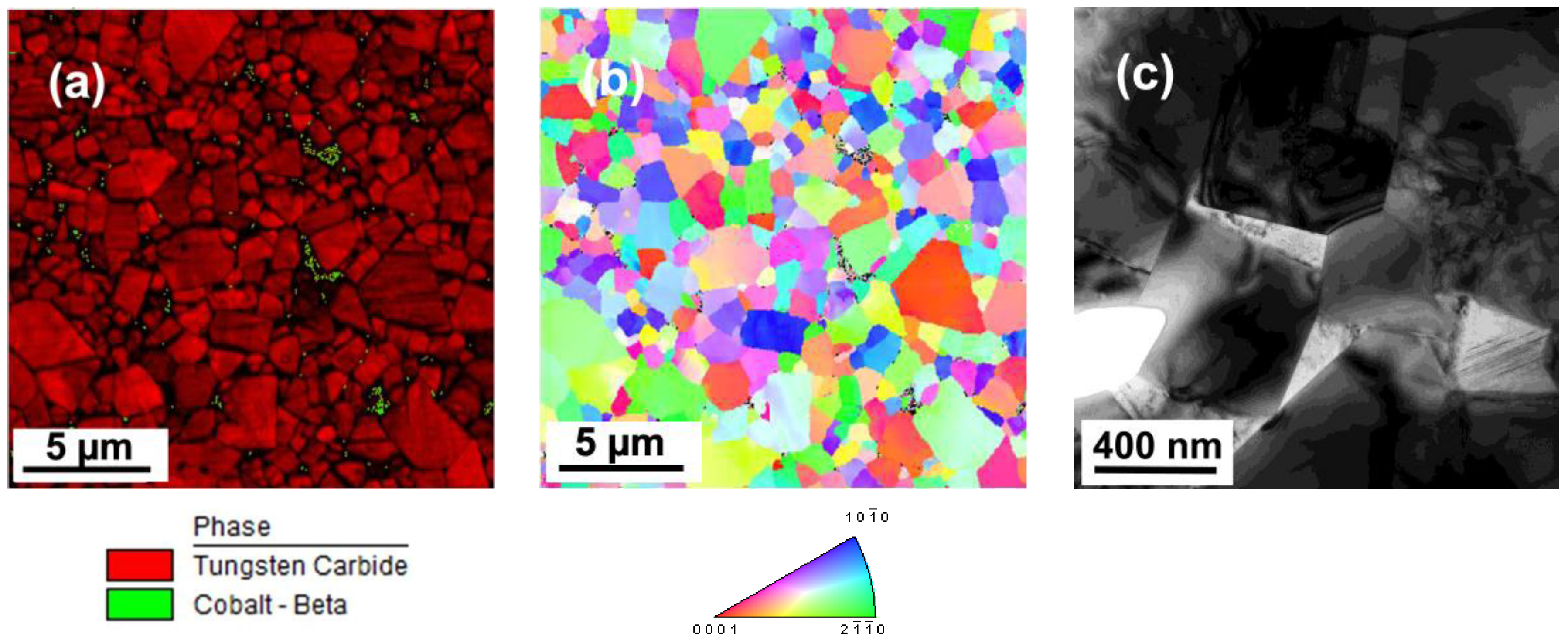
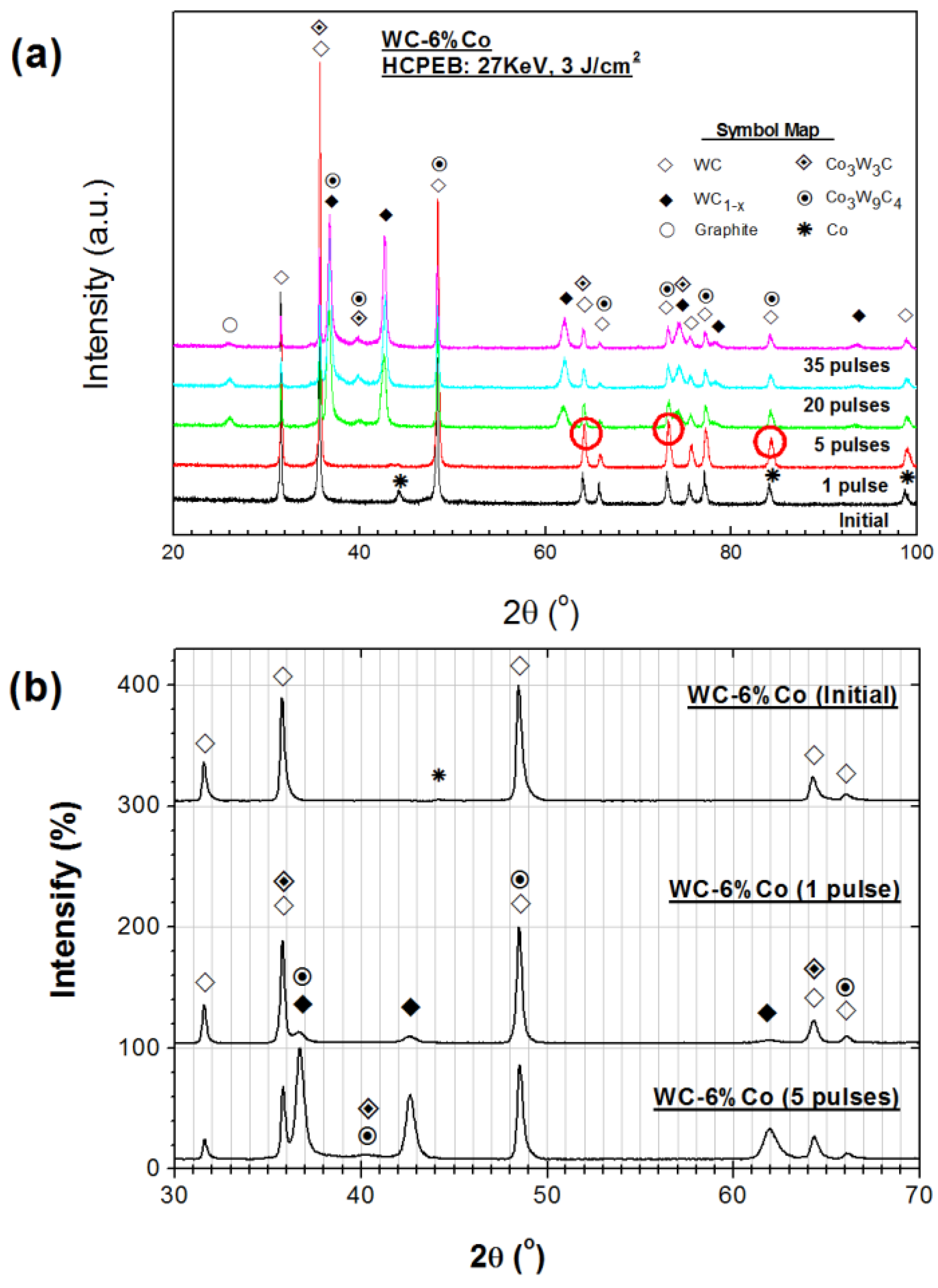
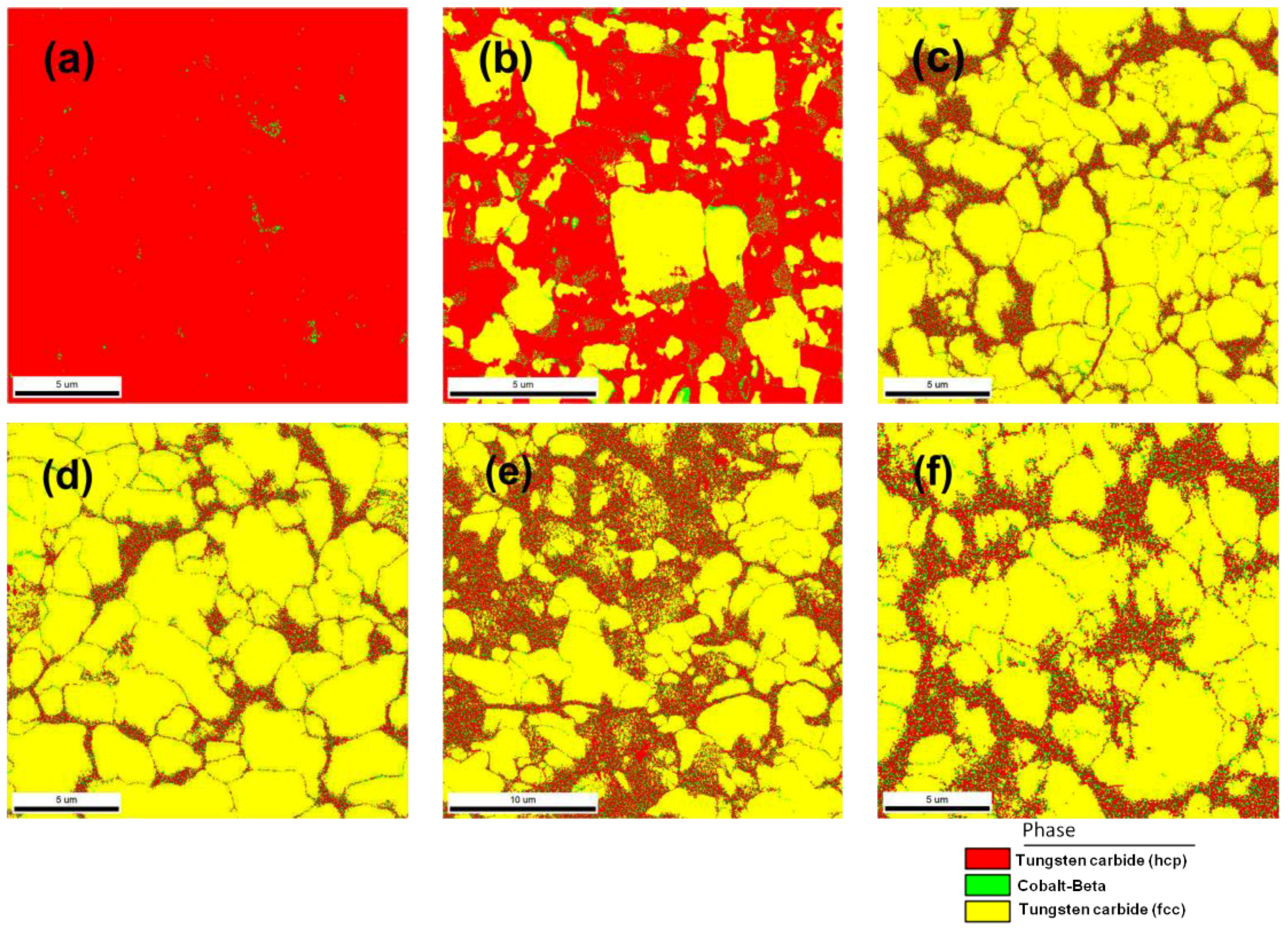


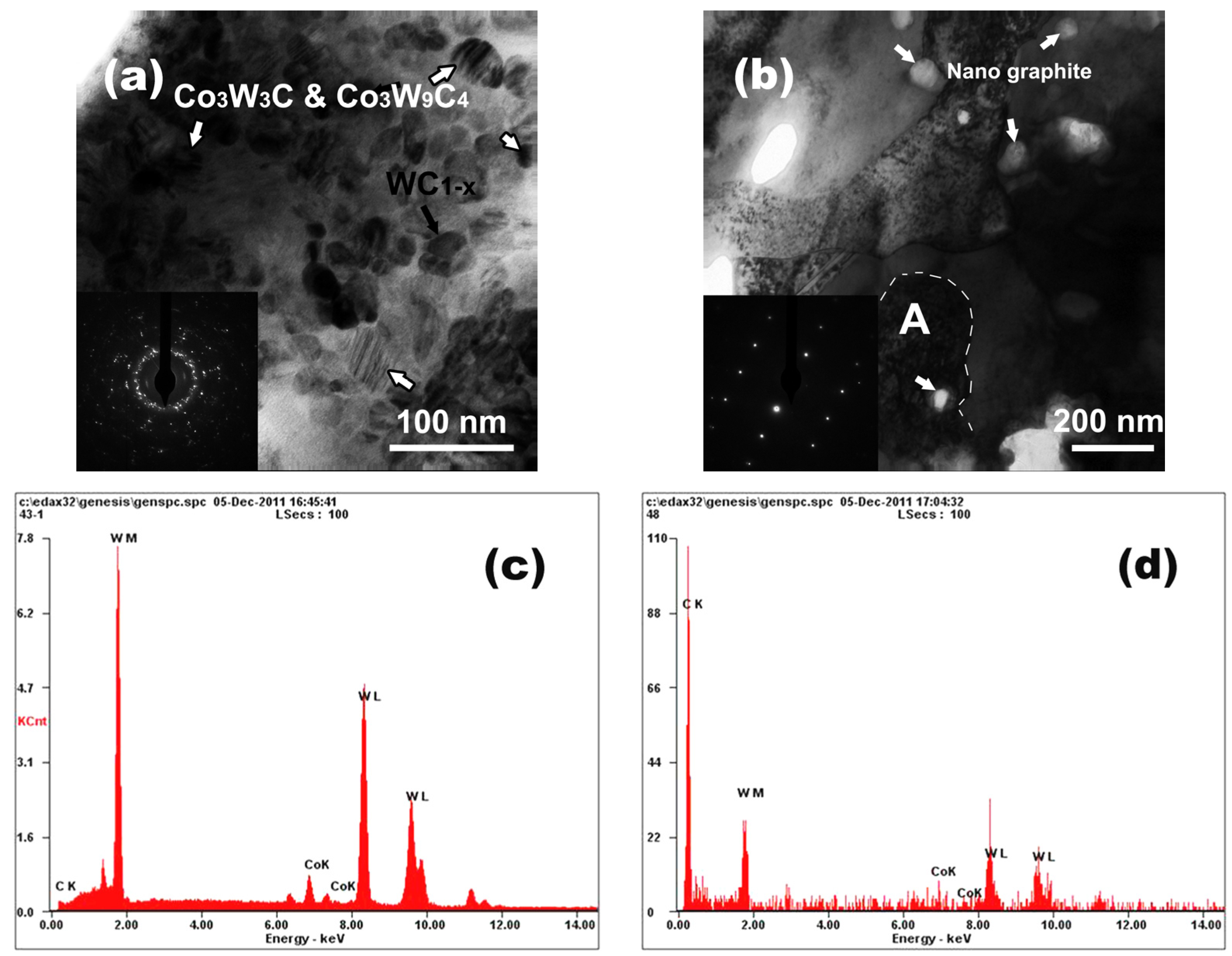
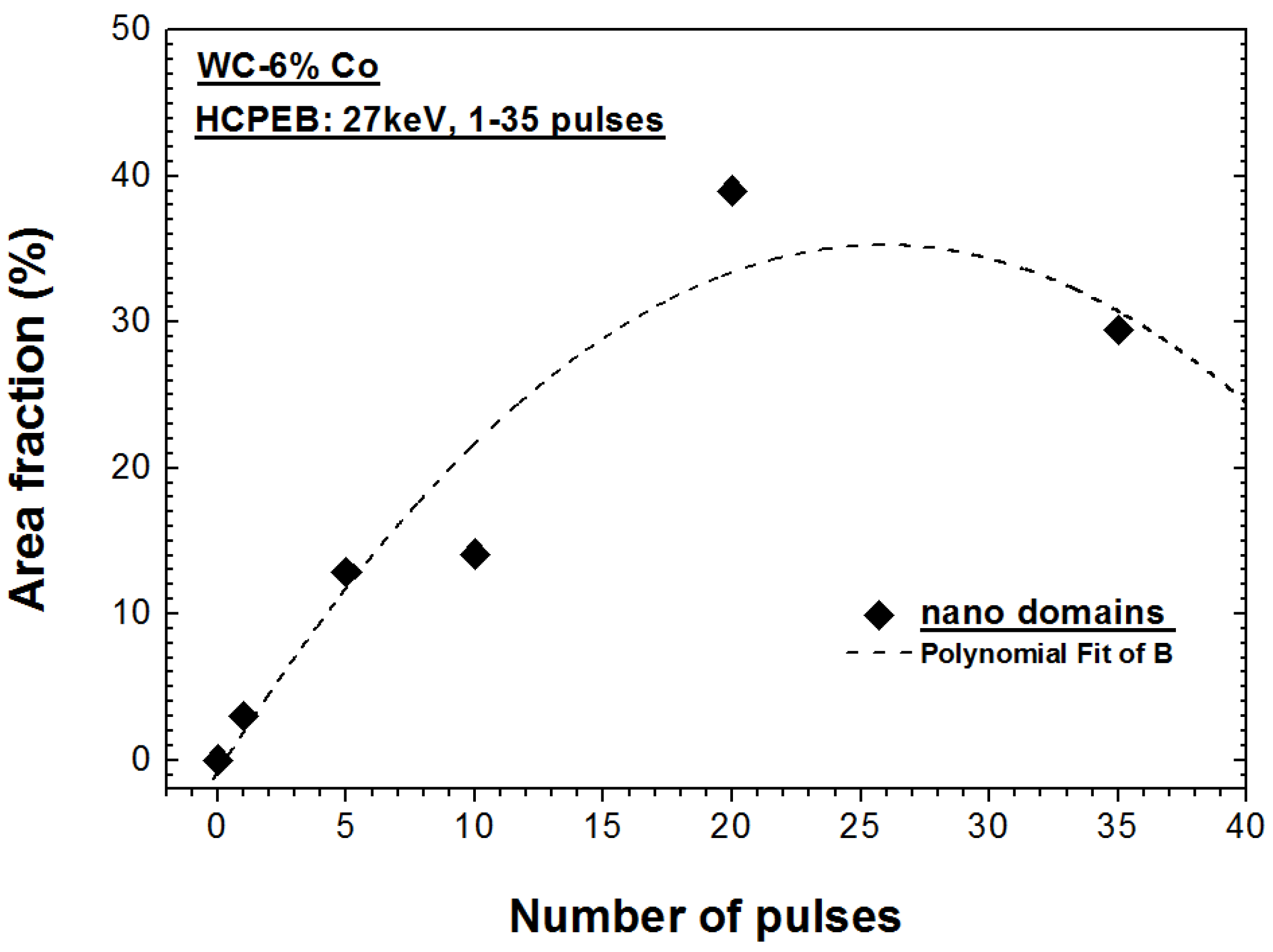
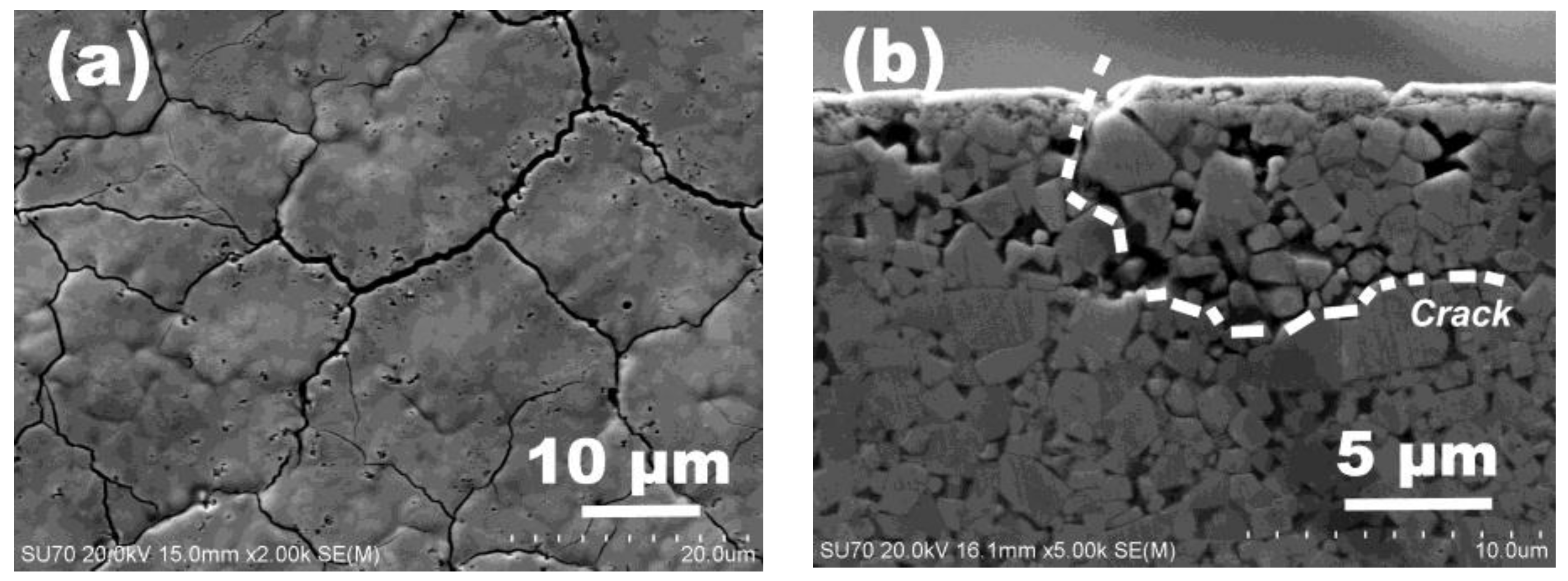
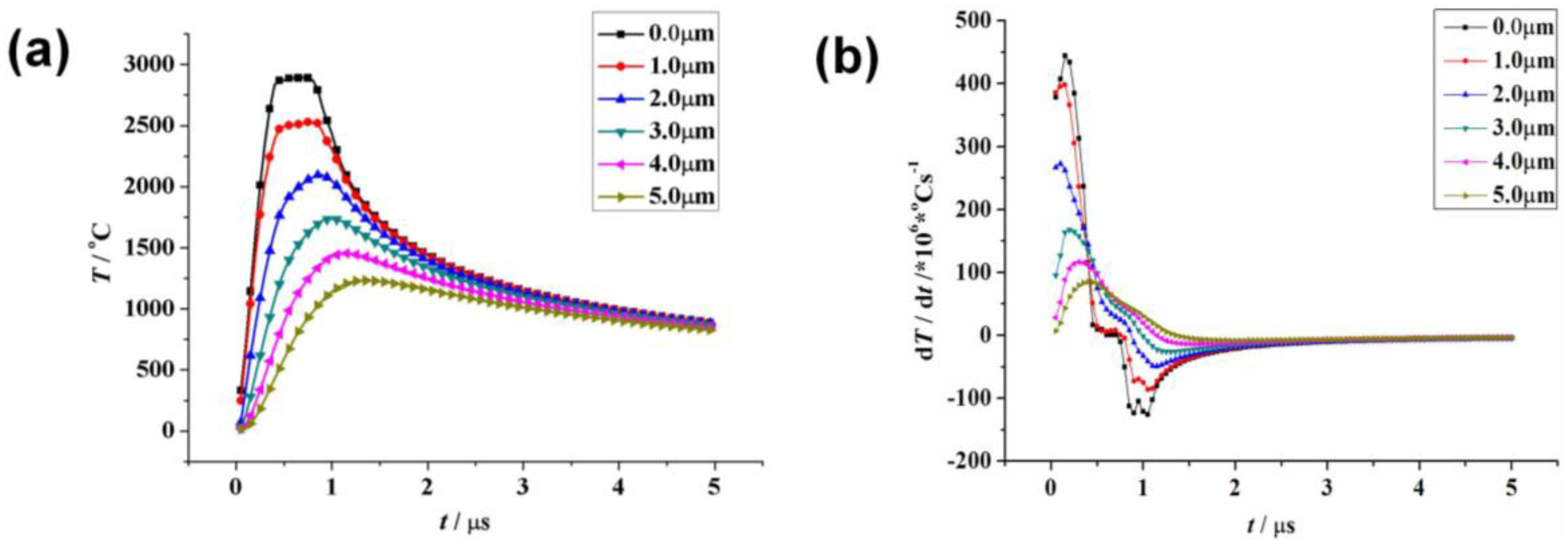
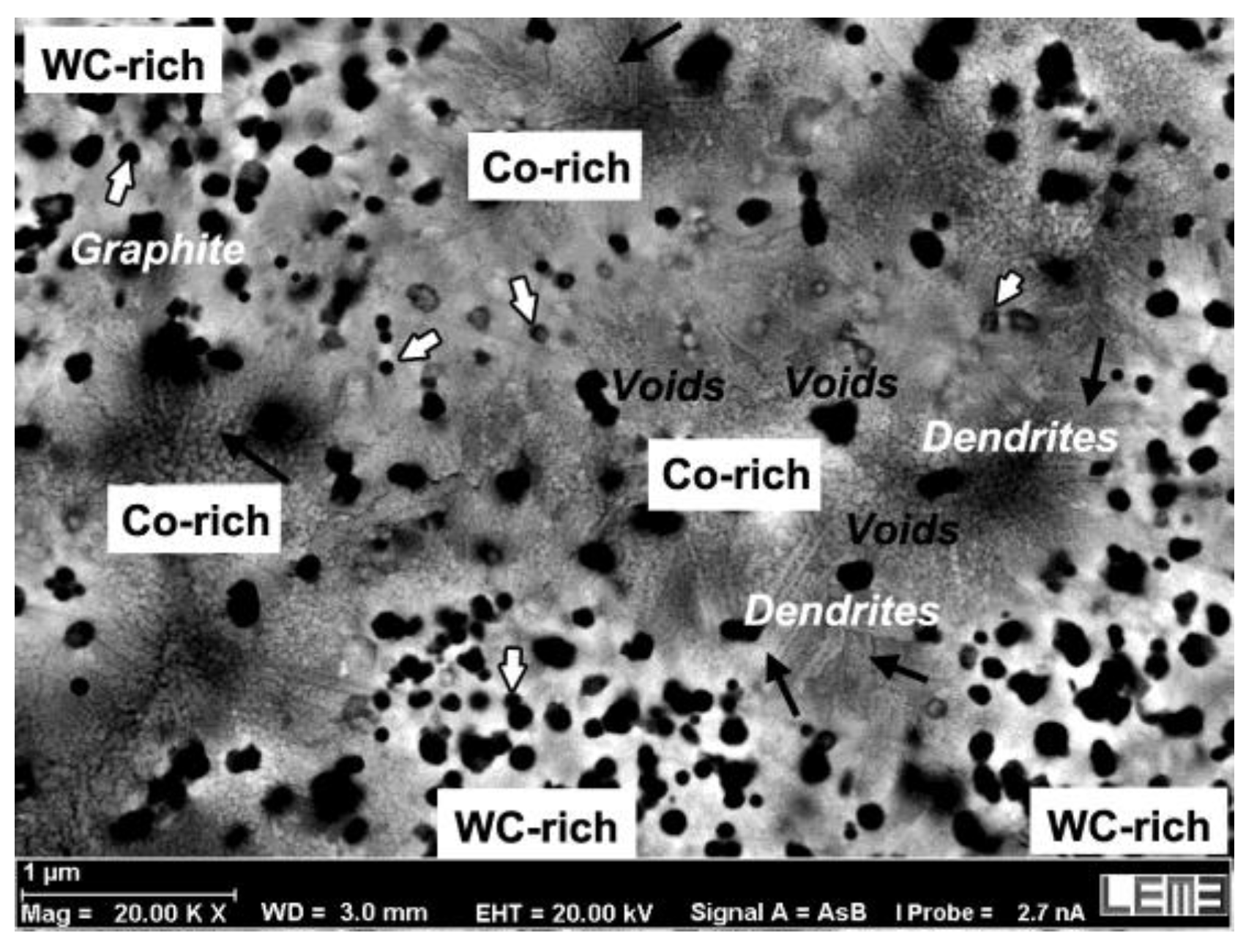
© 2017 by the authors. Licensee MDPI, Basel, Switzerland. This article is an open access article distributed under the terms and conditions of the Creative Commons Attribution (CC BY) license (http://creativecommons.org/licenses/by/4.0/).
Share and Cite
Zhang, Y.; Yu, F.; Hao, S.; Dong, F.; Xu, Y.; Geng, W.; Zhang, N.; Gey, N.; Grosdidier, T.; Dong, C. Evolution of Nanostructure and Metastable Phases at the Surface of a HCPEB-Treated WC-6% Co Hard Alloy with Increasing Irradiation Pulse Numbers. Coatings 2017, 7, 178. https://doi.org/10.3390/coatings7110178
Zhang Y, Yu F, Hao S, Dong F, Xu Y, Geng W, Zhang N, Gey N, Grosdidier T, Dong C. Evolution of Nanostructure and Metastable Phases at the Surface of a HCPEB-Treated WC-6% Co Hard Alloy with Increasing Irradiation Pulse Numbers. Coatings. 2017; 7(11):178. https://doi.org/10.3390/coatings7110178
Chicago/Turabian StyleZhang, Yue, Fuyang Yu, Shengzhi Hao, Fuyu Dong, Yang Xu, Wubin Geng, Nannan Zhang, Nathalie Gey, Thierry Grosdidier, and Chuang Dong. 2017. "Evolution of Nanostructure and Metastable Phases at the Surface of a HCPEB-Treated WC-6% Co Hard Alloy with Increasing Irradiation Pulse Numbers" Coatings 7, no. 11: 178. https://doi.org/10.3390/coatings7110178





